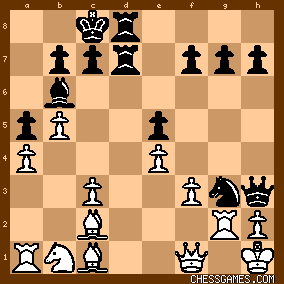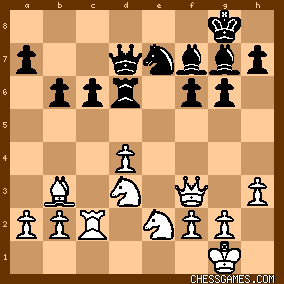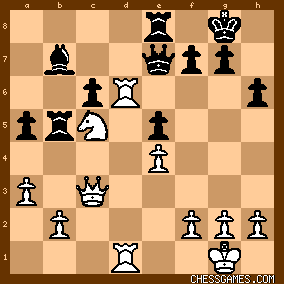|
< Earlier Kibitzing · PAGE 2 OF 3 ·
Later Kibitzing> |
| Mar-29-12 | | rilkefan: I had 19...Nf4 20.gxf Bc4 21.Qe1 Qxf3, which is crushing, but nothing like as good as the game line. Not a great week. |
|
| Mar-29-12 | | ZScore: I believe that I have a solution without the use of 20...Bf1. Does anyone agree with 19...Bc4 20. Qe1 (20. Qxc4 Rd1+ 21. Bxd1+ Rxd1+ 22. Rg1 Rxg1#) Rd2 (threatening 21...Qxg#) 21. Bxd2 (21. Rxd2 Nxg3+ 22. Qxg3 Qf1+ 23. Qg1 Qxg1#) Rxd2 22. Qxd2 (22. Rxd2 Nxg3+ 23. Qxg3 Qf1+ 24. Qg1 Qxg1#) Nxg3+ 23. Rxg3 Qf1+ 24. Rg1 Qxg1#. |
|
| Mar-29-12 | | newzild: <ZScore>
Nice try, buddy, but I think I can see a flaw.
After 19...Bc4 20. Qe1 Rd2 21. Bxd2 Rxd2 (your main line), White does not have to capture with the queen, but can instead play 22. Nxd2, when the knight and queen both cover the f1 square, stopping Black's bishop from moving there. |
|
| Mar-29-12 | | ZScore: <newzild>
Thank you for responding to my post. I feel like you just blocked my attempt at a slam dunk. WOW, that was painful! |
|
| Mar-29-12 | | BadKnight: white king has no move, so its just a matter of breaking through. one simple check and it would be it. so i tried all the possible regular forcing checks, but it appears white just holds, so the next idea is to find indirect moves. so, 1...Bc4 deflecting the queen, the queen can't leave the protection of d1 square, so 2.Qe1 is the only move. next i tried to deflect the queen again with forcing 2...Bf2, which again did not work. then i spotted 2...Bf1 creating threat on g2. now 3.Qxf1 is forced, and after 3...Nxg3+ the only move 4.Rxg3 forces 4...Qxf1 5.Rg1 Qxg1 mate. |
|
| Mar-29-12 | | sevenseaman: Equal.
First thoughts: It does not work at the moment but the wild urge is to play 19...Nxg3+. With a good back rank potential (doubled Rs), the other idea hitting the senses is to divert the Q with 19...Bc4. I think I'll go with the pragmatic (more workable at the moment) 19...Bc4. The Q finds it tough to continue her vigil on d1. In fact she perhaps has no good square & cannot do better than take c4(inserting the LSB at d3 is a cold-blooded...whatever). May be White could temporize with 20. Qe1 but it is still only a subterfuge. Black has already written off his LSB and he is hellbent on its sac wherever it fits. After these thought I arrive at this variety of obituary for White; i)
<19...Bc4 20. Qxc4 Rd1+ 21. Bxd1 Rd1+ 22. Rg1 Rxg1#>. ii)
<19...Bc4 20 Qe1 Bf1> (Threat Qxg2#; withdrawing the R to g1 loses to 21...Bxg1 with same threat still on) <21. Qxf1 Nxg3+>. 1-0 [as 21.Rxg3 Qxf1#] 
click for larger viewThe Rs for back rank mate were not even needed in this last combination. I could write some more combos but these are all pointless, futile and at best pedantic. Folks will feel a tad easier today. It could well change places with yesterday's POTD. |
|
| Mar-29-12 | | sevenseaman: What was the problem at midnight USA?
A fragment of the pedantry I was referring to (in the main post); <iii)
<19...Bc4 20. Qe1 Bf1 21. Rg1 Bxg1 22. Qxf1 Ng3+ 23. Kxg1 Qxf1#>. And there are more. |
|
| Mar-29-12 | | KingV93: While I did see Bc4 I did not see the details of the finish, I'm either getting used to the theme of some puzzles or improving my chess intuition. I'd like to think the latter! |
|
| Mar-29-12 | | gofer: It took seconds to see that 19 ... Bc4 was a good move. <19 ... Bc4>
As the bishop is immune to capture due to 20 Qxc4 Rd1+ mating. White only really
has one response that doesn't lose a huge amount of material. <20 Qe1 ...>
But it took me another half an hour to see the next move. White's
defenses are not so terrible. I looked at Bd3 and Rd3, but eventually I saw
the key move.
<20 ... Bf1!>
That must have come as a pretty big shock for white and the horrible realisation
that white is now going to lose and infact probably be mated quite quickly
in all scenarios. Again, the bishop is immune.
21 Qxf1 Nxg3+ 22 Rxg3 Qxf1+ mating
White must deal with 21 ... Bxg2#/Qxg2#.
21 Rf2 Nxg3+ 22 Kg1 Qg2#!!
21 Rg1 Bxg1 mating
21 Re2 Rd1 22 Bxd1 Rxd1 mating
Time to check... |
|
| Mar-29-12 | | agb2002: The material is equal.
On the one hand, if we remove the white queen from the board then Black would deliver mate in three with 19... Rd1+ 20.Bxd1 Rxd1+ 21.Rg1 Rxg1# or 19... Nxg3+ 20.Rxg3 Qf1+ 21.Rg1 Qxg1#. On the other hand, the attack seems to need more wood. Therefore, 19... Bc4: A) 20.Qxc4 (allows the first mate) 20... Rd1+, etc.
B) 20.Qe1 Bf1
B.1) 21.Qxf1 (allows the second mate) 21... Nxg3+, etc. B.2) 21.Rd2 Rxd2 22.B(N)xd2 Qg2#.
B.3) 21.Re2 Rd1 22.Bxd1 Rxd1 23.Qxd1 Nxg3#.
B.4) 21.Rf2 Nxg3#.
C) 20.Bd3 Bxd3 doesn't solve anything for White. |
|
| Mar-29-12 | | whiteshark: <19...Bc4> and that's it. |
|
| Mar-29-12 | | Oxspawn: There is a back rank mate waiting to happen but a number of things to be cleared out of the way first. So I am setting off on a series of suicide missions which if they work out lead to glory and if they fail lead to ignominy. Either “death and glory” or “death and sorry”. This is my main line giving up a bishop and a rook: 19. … Bc4
20. Qxc4 Rd1+
21. Bxd1 Rxd1+
22. Rg1 Nxg3++, or indeed simply Rxg1++
What if the queen does not take the bishop on move 20? Interposing white’s light squared bishop does not help as it gets taken without advantage. The queen can move but there is only one square where she cannot be taken by one of the bishops or the rook.
20. Qe1 Bf1 (continuing to try to sacrifice itself)
21. Qxf1 (or how does white prevent Qxg2++?)
21…. Nxg3+
22. Rxg3 Qxf1+
23. Rg1 Qxg1++
I was stumped for a while after Qe1 but after the two bishop moves this seems to play itself (or I have made another mistake). Better go and look at the game… |
|
| Mar-29-12 | | Oxspawn: I got this one right. Since starting to try to do these every day and eventually understanding why I should try to do it in my head instead of by shufflng pieces around, I have definitely improved my ability to see positions and threats - so thanks to everyone who makes this site possible. However, I still need help to a) come out of the opening without being already lost and b) someone to lean over my shoulder and tell me when I am in a 'puzzle position' when I should look for a killer move. The first bishop move is quite easy to see once you know it is a puzzle, but over the board would I have seen it? Or dared to play it? |
|
| Mar-29-12 | | sevenseaman: <Oxspawn> Great! Many happy returns of the <POT>day. <over the board would I have seen it? Or dared to play it?> The dilemma of OTB life! I dare say I do not know how many times such plums have come and gone. If one does spot, one has to calculate next 3-4 moves to be sure of getting away with the robbery. After it is accomplished every heist looks simple. Today's puzzle is a real charmer. Bc4 wouldn't occur if those two Rs weren't lined up menacingly. To think they played no part whatsoever in one important combination! |
|
| Mar-29-12 | | Patriot: Material is even.
I think I finally see it. 19...Bc4 is easy enough to find, attempting to remove the queen's defense on d1. But the follow-up was not. 20.Qxc4?? Rd1+ 21.Bxd1 Rxd1+ and mates.
20.Qe1 Bf1! and white probably resigns. 21.Qxf1 Nxg3+ 22.Rxg3 (forced) Qxf1+ 23.Rg1 Qxg1# |
|
| Mar-29-12 | | sevenseaman: The kind of plums we let go;

click for larger viewWhite.
And the kind that manage to decoy us into precipitate action. 
click for larger viewWhite.
<Patriot> <But the follow-up was not>. 21...Bf1 wasn't easy to find; after that its 'autopilot'. |
|
| Mar-29-12 | | Limpin Kt: <sevenseaman> 1Bf7 kf7 2.Ne5 and 1Rd7 wins. In potd i saw 19...Bc4 but after 20.Qe1 failed to visualize 20.:.Bf1! No credits today :( |
|
| Mar-29-12 | | CHESSTTCAMPS: How did white get into such a miserable defensive position so early? Material is even, but all
black pieces are actively deployed, while 3 white pieces languish on their original queenside
squares. It's obvious that white's Q+Rg2 are overmatched by black's 6 active pieces; both of these
white major pieces are overloaded. The weak back rank suggests diverting the white queen from its
defensive post.
19... Bc4! does the trick:
A) 20.Qxc4 Rd1+ 21.Bxd1 Rxd1+ 22.Rg1 Nxg3#
B) 20.Qe1 Bf1!! 21.Qxf1 (Rg1 Bxg1 22.Kxg1 Qg2#) Nxg3+ 22.Rxg3 Qxf1+ 23.Rg1 Qxg1# C) 20.Qd2 Nxg3+! 21.Rxg3 Qf1+ 22.Rg1 Qxg1#
D) 20.Bd3 Bxd3 21.Q moves Bf1! again finishes quickly . Most likely, the game went into B and white resigned at move 21. |
|
Mar-29-12
 | | Penguincw: Some how, I managed to calculated the "long variation". I'm 3.5/4 this week. |
|
| Mar-29-12 | | En prise: Oxspawn good job in getting the puzzle correct.
A) study good opening fundamentals. Choose one or two openings for white and black. Play them and know them as best you can. That should help you to come out of the opening at least equal. You can go on from there. B) That's the whole point. OTB there IS nobody looking over your shoulder to tell you when there's a combination ,when the game is at a critical stage etc. Those are two reasons that all of us here find chess to be such a fantastic fascinating game (or sport). |
|
| Mar-29-12 | | sevenseaman: There are pointers in the position that you need to play carefully. It only looks a sitter.
click for larger viewWhite.
<Limpin Kt: <<sevenseaman> <1Bf7 kf7 2.Ne5 and 1Rd7 wins. In potd i saw 19...Bc4 but after 20.Qe1 failed to visualize 20.:.Bf1! No credits today. <<>>>> I warned you there was a decoy. You gotta do one of them again. |
|
| Mar-29-12 | | VincentL: "Medium".
Another back rank theme today.
Black has many pieces in the attack; the question is how to divert white´s Q + R so that they cannot defend key squares. I am looking at 19.....Bc4. Now if 20. Qxc4 Rd1+ 21. Bxd1 Rxd1+ and mate follows (22. Qf1 Rxf1+ 23. Rg1 Rxg1#) What other defensive options does white have?
20. Qe1. Here I think 20.....Bf1 !. Now if 21. Qxb1 Ng3+ and the white queen is lost 22. Rxg3 Qxf1+, or 22. Kg1 Nxf1 Black is threatening 22....Qf2#, and if white moves his queen to the second rank to defend f2, it will be immediately captured (Rxd2, Bxe2 or Bxf2). I think this is the solution.
Let´s check. |
|
| Mar-29-12 | | Memethecat: 19...Bc4!
If the sac is accepted =
20Qxc4 Rd1+ 21Bxd1 Rxd1+ 22Qf1 Rxf1+ 23Rg1 Nxg3#
If refused (more likely) =
20Qe1 Bf1¹ 21Qxf1 Nxg3+ 22Rxg3 Qxf1+ 23Rg1 Qxg1#
¹! threatens mate
******** |
|
| Mar-29-12 | | TheaN: Thursday 29 March 2012
<19....?>
Material: even
Candidates: Nxg3†, Qxg2†, Rd1, Rd2, <[Bc4]> In this kind of positions the attacking player does good to play well thought over reinforcing moves. They may be combinations, but being too agressive may backfire where it was not at all necessary. Contradiction, I'd say. Last Thursday I lost a game where I was completely winning even without pushing my opponent's castled wing, and gave away the game being way too agressive. Yeah, I'm back and immediately you get my frustrating experiences to endure. Enjoy. Ah well, back to this one. Many moves can do Black apart, considering he's so overwhelming White even without doing anything, he should be careful. One safe reloading move is the destructive: <19....Bc5!> with the point being 20.Qxc5 Rd1† 21.Bxd1 Rxd1† 22.Qf1 Rxf1† 23.Rg1 Nxg3‡ 0-1, which on its own is a neat mate. Given this impossible move however, the White queen is very exposed, the Black rooks down the d-file, and the bishops scope both a6-f1 and a7-g1. This leaves White with the plain losing 20.Bd3 Bxd3, or: <20.Qe1> this seems to hold. d1 still protected, g3 protected anew, g2 needed no protection. Hm. g2 needed no protection. We can make it need protection, of course. <20....Bf1!> thoughts like the above lead to moves like this. When I saw Bc4, Bf1 was already clear. White is ill-fated to try 21.Qxf1 Nxg3† 22.Rxg3 Qxf1†  . Alternatives however, are not readily available. Qxg2‡ has to be avoided. Only the rook can move, and the only reasonable placement seems to be: . Alternatives however, are not readily available. Qxg2‡ has to be avoided. Only the rook can move, and the only reasonable placement seems to be: <21.Re2> but White is still done after: <21....Bxe2  > the bishop is immune due to Nxg3†, similar after 21.Rd2 Rxd2 and it's over. > the bishop is immune due to Nxg3†, similar after 21.Rd2 Rxd2 and it's over. |
|
| Mar-29-12 | | kevin86: This was a very subtle puzzle:a combination of tactics is required: the decoy
The back row attack
the attack from behind,
the pin
not bad,eh? |
|
 |
 |
|
< Earlier Kibitzing · PAGE 2 OF 3 ·
Later Kibitzing> |





